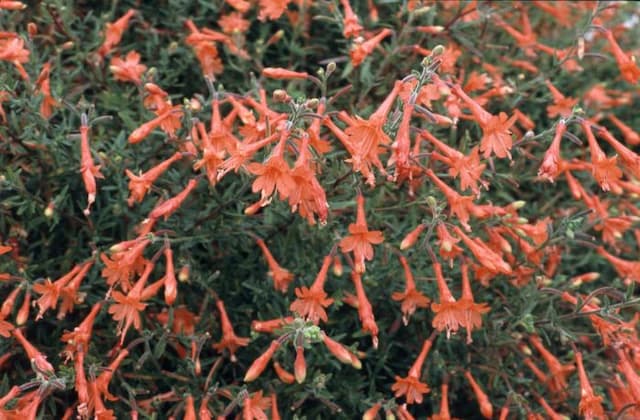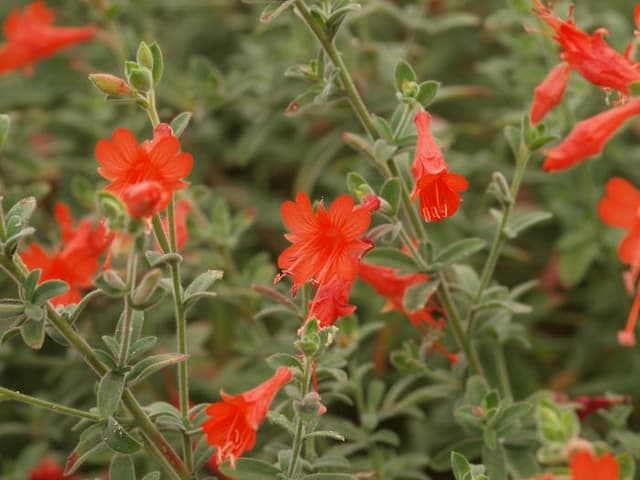Pink Gaura Oenothera lindheimeri 'Passionate Pink' (G)

ABOUT
The plant commonly known as Passionate Pink Gaura has a distinct and graceful appearance with its airy and delicate look. It showcases a profusion of deep pink flowers which bloom along thin, long stems that rise elegantly above the foliage. These blooms resemble little butterflies fluttering in the breeze, hence the plant is sometimes called the Whirling Butterflies. The foliage of Passionate Pink Gaura is lance-shaped, with a green to sometimes reddish tinge, providing a lovely contrast to the vivid pink of the flowers. The leaves form a basal clump from which the flower stems emerge, creating a very natural and open, slightly bushy form. The flowers tend to open in the morning and close in the evening and are favorite attractions for bees, butterflies, and other pollinators. Over the flowering season, which extends from early summer to the first frosts of fall, the display of Passionate Pink Gaura is a dynamic and long-lasting addition to any garden setting, adding movement and color without dominating the space. Overall, it exudes a sense of wild and unbridled beauty, bringing life and charm wherever it grows.
About this plant
 Names
NamesFamily
Onagraceae.
Synonyms
Evening Primrose, Gaura, Lindheimer's Beeblossom, Wand Flower, White Gaura, Butterfly Gaura, Passionate Pink Gaura.
Common names
Gaura lindheimeri, Oenothera lindheimeri
 Toxicity
ToxicityTo humans
Pink Gaura (Oenothera lindheimeri 'Passionate Pink') is not known to be toxic to humans. No significant symptoms of poisoning are expected from ingesting parts of this plant. However, individual sensitivities can vary, and consuming non-edible plants is generally discouraged.
To pets
Pink Gaura is not known to be toxic to pets. It is not expected to cause any significant symptoms of poisoning if pets ingest parts of this plant. As with humans, individual sensitivities can vary, and it is generally not advisable for pets to consume non-edible plants.
 Characteristics
CharacteristicsLife cycle
Perennials
Foliage type
Deciduous
Color of leaves
Green
Flower color
Pink
Height
2-3 feet (60-90 cm)
Spread
2-3 feet (60-90 cm)
Plant type
Herb
Hardiness zones
6-9
Native area
North America
Benefits
 General Benefits
General Benefits- Aesthetic Appeal: Oenothera lindheimeri 'Passionate Pink', commonly known as Gaura, adds beauty to gardens with its delicate pink flowers and graceful, wand-like stems.
- Attracts Pollinators: Gaura is known for attracting bees, butterflies, and other beneficial pollinators, promoting biodiversity in the garden.
- Drought Tolerance: Once established, Gaura is quite drought-tolerant, making it an excellent choice for water-wise landscapes or areas prone to water restrictions.
- Low Maintenance: This plant requires minimal care, as it is resistant to pests and diseases, and needs little pruning or deadheading.
- Long Blooming Season: Gaura offers a long flowering period from early summer until fall, providing extended interest in the garden.
- Deer Resistance: It is generally resistant to grazing by deer, making it a great option for gardens in areas with a large deer population.
- Versatility: Suitable for various garden styles, including wildflower, cottage, and contemporary gardens, as well as in containers.
- Soil Adaptability: Gaura can thrive in a variety of soil types, although it prefers well-drained soils.
- Heat Tolerance: It can withstand high summer temperatures, making it a robust choice for hot climates.
- Fast Growth: Gaura grows quickly and can fill in garden spaces in a short amount of time, providing immediate impact.
 Medical Properties
Medical PropertiesThis plant is not used for medical purposes.
 Air-purifying Qualities
Air-purifying QualitiesThis plant is not specifically known for air purifying qualities.
 Other Uses
Other Uses- Garden Art Medium: The stems and flowers of Gaura can be used to create natural garden sculptures or floral art pieces, offering an aesthetic appeal when arranged artistically.
- Photography: Gaura's elegant blooms provide a compelling subject for photographers, especially those specializing in botanical and nature photography.
- Educational Tool: Schools and educational programs can use Gaura to teach students about plant life cycles, pollination, and native plant gardening.
- Craft Material: Dried Gaura flowers can be incorporated into crafts, such as making bookmarks, greeting cards, or potpourri.
- Environmental Studies: Can serve as a model in environmental studies, demonstrating the importance of native plants in supporting local ecosystems.
- Habitat Creation: Planting Gaura in garden spaces can create micro-habitats for beneficial insects and small wildlife, fostering biodiversity.
- Erosion Control: Gaura's root systems can help stabilize soil in areas prone to erosion, making it useful in landscape restoration projects.
- Nomenclature Inspiration: The unique appearance of Gaura can inspire names for things such as paint colors, artistic styles, or even literary metaphors.
- Lighting Inspiration: The delicate nature of Gaura flowers could inspire design elements for lamps or other lighting fixtures, mimicking its form and grace.
- Seasonal Decorations: Gaura's flowers, with their long blooming period, can be used as living decorations in seasonal garden displays or events.
Interesting Facts
 Feng Shui
Feng ShuiThe plant Gaura is not used in Feng Shui practice.
 Zodiac Sign Compitability
Zodiac Sign CompitabilityThe plant Gaura is not used in astrology practice.
 Plant Symbolism
Plant Symbolism- Hope: Oenothera, commonly known as "gaura," symbolizes hope due to its ability to thrive in harsh conditions and its continuous production of flowers even in difficult circumstances.
- Purity: The 'Passionate Pink' variety's delicate pink blossoms are often associated with purity and innocence.
- Resilience: Gauras are drought-tolerant plants indicative of resilience and the capacity to adapt and persist through challenges.
- Peace: The gentle swaying of gaura flowers in the wind can evoke a sense of calm and tranquility, hence symbolizing peace.
- Love: With 'Passionate Pink' in its name, this gaura variety can represent love and affection, suggesting a deep and passionate connection.
 Water
WaterGaura, commonly known as the Wand Flower, prefers a well-draining soil and should be watered when the top inch of soil feels dry to the touch. In general, watering once a week with approximately one gallon per plant should suffice. However, during particularly hot or dry spells, watering frequency may need to increase to twice a week to ensure the soil remains consistently moist. Be careful not to overwater as gauras do not like to sit in wet soil, which can promote root rot. Adjust the amount and frequency of watering based on rainfall and temperature, reducing water in cooler, wetter periods.
 Light
LightThe Wand Flower thrives in full sun receiving at least 6 hours of direct sunlight every day. The best spot for this plant would be in an area of the garden that receives unobstructed sun exposure for most of the day. Avoid placing it in areas with too much shade as this can reduce flowering and lead to leggy growth.
 Temperature
TemperatureThe Wand Flower does well in a range of temperatures and can handle minimum temperatures down to about 50 degrees Fahrenheit. The ideal growing temperature for this plant is between 60 to 85 degrees Fahrenheit. It can survive short periods of higher temperatures if appropriately watered, but consistently high temperatures above 90 degrees Fahrenheit may stress the plant.
 Pruning
PruningThe Wand Flower benefits from pruning to encourage bushier growth and more flowers. Prune in early spring by cutting back the previous year's growth to about one-third of its size. Further, deadheading spent blooms during the growing season will promote continuous flowering. After flowering has finished, pruning can also be done to maintain an attractive shape and remove any dead or damaged wood.
 Cleaning
CleaningAs needed
 Soil
SoilGaura, also known as Oenothera lindheimeri 'Passionate Pink', thrives in well-draining soil that is rich in organic matter. A good mix would be two parts garden soil, one part peat moss or coconut coir, and one part perlite or sharp sand. The ideal soil pH for Gaura should be slightly acidic to neutral, ranging from 5.5 to 7.0.
 Repotting
RepottingGaura, commonly referred to as Whirling Butterflies, does not often need to be repotted as it is a perennial that can be left in the same spot for several years. Repotting is typically necessary only if the plant has outgrown its container or if the soil has become exhausted, which is usually every 3-4 years.
 Humidity & Misting
Humidity & MistingWhirling Butterflies prefer moderate humidity levels but are quite adaptable and can tolerate dry air. They do not require any special humidity adjustments when grown outdoors, making them suitable for a wide range of environments.
 Suitable locations
Suitable locationsIndoor
Place Gaura in bright indirect light indoors.
Outdoor
Plant Gaura in full sun with well-draining soil.
Hardiness zone
5-9 USDA
 Life cycle
Life cycleOenothera lindheimeri 'Passionate Pink', commonly known as Pink Gaura, begins its life as a seed, which when sown in well-drained soil and with adequate warmth, germinates to produce small seedlings. As it enters the vegetative stage, the plant develops a rosette of leaves and a deep taproot, followed by upright stems that can reach up to 2-4 feet tall. During the flowering stage, which occurs from late spring through autumn, it produces delicate pink flowers that flutter on long, slender stems, attracting pollinators like bees and butterflies. After pollination, the flowers develop into small nutlet fruits that contain seeds for the next generation. In the dormant stage over winter or in response to drought, Pink Gaura may die back to the ground, relying on its taproot to survive and regrow when favorable conditions return. As a perennial, Oenothera lindheimeri 'Passionate Pink' can repeat this life cycle for several years, flowering annually and proliferating through both seed dispersal and vegetative propagation.
 Propogation
PropogationPropogation time
Spring-Early Summer
Propogation: Oenothera lindheimeri 'Passionate Pink', commonly known as Pink Gaura, is usually propagated in late winter to early spring before new growth begins. The most popular method of propagation for this plant is by division. To propagate by division, carefully dig up the plant, ensuring to keep a good amount of the root system intact. Then, using a sharp shovel or knife, divide the clump into smaller sections, each with several shoots and a portion of the root system. Replant the divisions at the same depth they were growing at before, spacing them around 12 to 24 inches apart (30 to 61 centimeters). Make sure the soil is well-draining and water the new plantings thoroughly. This helps to ensure that the divisions establish themselves quickly and begin to grow into healthy, independent plants.









